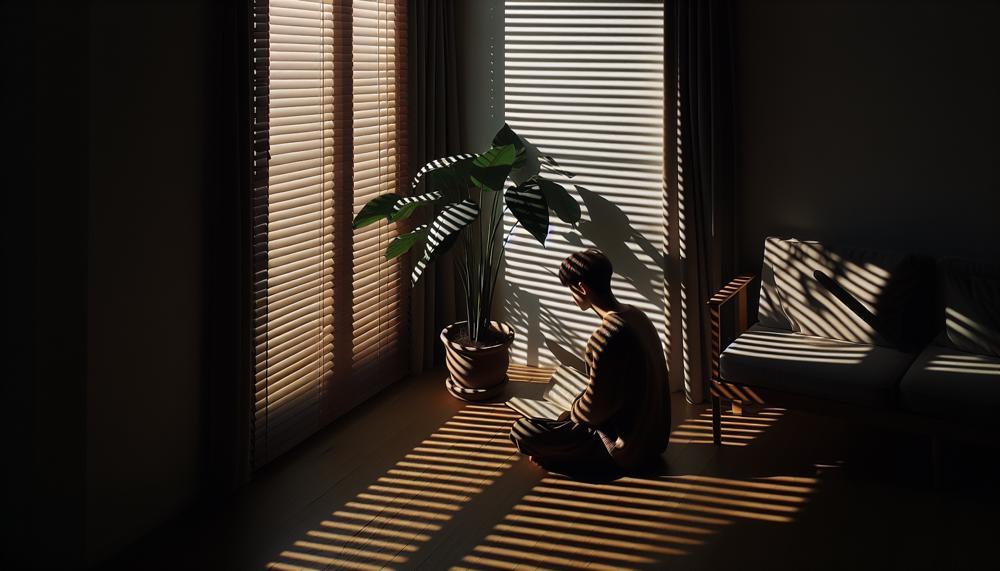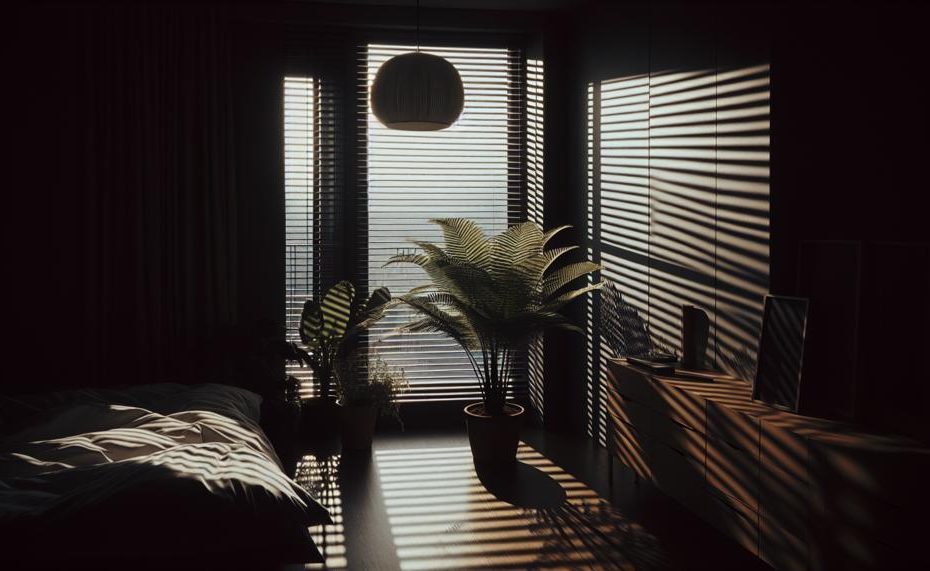Have you ever caught yourself gazing at the shadows peeking through your blinds, captivated by their rhythmic movements and enigmatic forms? It’s a common occurrence that often slips by unnoticed in our hectic lives. But what if I told you that these seemingly ordinary shadows hold a deeper significance and can even unveil hidden facets of ourselves and our environment?
In this blog post, we’ll embark on a journey into the intriguing world of seeing shadows through blinds. From the science behind how light creates these shadows to the psychological impact they have on us, we’ll explore every facet of this fascinating phenomenon.
So grab a steaming cup of coffee, get comfortable, and let’s shed some light on those elusive shadows.
Here are some key points we’ll delve into:
- The fundamentals of how light interacts with objects to produce shadows
- The various types of blinds and their influence on shadow patterns
- The role of our brain in interpreting and perceiving these shadows
- The potential symbolism behind perceiving specific shapes or figures in the shadows
- Tips for utilizing blinds to intentionally create shadow art in your home or workplace
Get ready to view those everyday shadows from a whole new perspective.
Let’s begin.
Contents
- 1 Can You See Shadows Through Blinds?
- 2 Can You See Shadows Through Horizontal Or Vertical Blinds At Night?
- 3 Can You See Shadows Through Curtains At Night?
- 4 Can You See Through Blinds During The Day Or Night?
- 5 Should Blinds Be Turned Up Or Down For Privacy?
- 6 Can My Neighbors See Through My Blinds?
- 7 How To Use Blinds For Privacy?
- 8 How Can I Cover My Window For Privacy Without Curtains?
- 9 Conclusion
Can You See Shadows Through Blinds?
The presence of blinds can significantly affect the visibility of shadows in a room, with various factors playing a role in managing this. These factors include the type and material of blinds, the angle of the slats, and external light sources, which we will explore in more detail below.
| Type and Material of Blinds | Effect on Shadow Visibility |
| Thicker fabrics and light-blocking materials | Decrease the visibility of shadows |
| Bamboo blinds | Diffuse light and minimize stark shadows |
| Vinyl or wood with tighter slats | Increase shadow concealment |
Blinds made from thicker fabrics or materials designed for light-blocking, such as blackout curtains, provide better concealment of shadows compared to thinner or sheer fabrics.
Additionally, bamboo blinds are effective in diffusing light and minimizing stark shadows. Opting for materials like vinyl or wood with tighter slats can also increase shadow concealment.
| Angle of Slats | Effect on Shadow Visibility |
| Angling slats downward | Minimizes visibility of external shadows |
| Adjusting slat angles | Improves internal shadow concealment |
The angle of the slats is another important factor in managing shadow visibility. Angling the slats downward can decrease the visibility of external shadows, while adjusting the slat angles can improve internal shadow concealment.
External light sources, such as the sun, can also impact the visibility of shadows through blinds. The direction in which the blinds are turned can affect the amount of light and visibility inside. To enhance privacy and control light intensity, consider layering with curtains or adding indoor plants.
Can You See Shadows Through Horizontal Or Vertical Blinds At Night?
The type of blinds you choose can significantly affect the visibility of shadows in your room at night. For instance, horizontal blinds with slats running parallel to the window may allow more light to seep through the gaps between slats, making shadows more noticeable.
In contrast, vertical blinds have slats that run vertically down the window, limiting the amount of light entering and reducing shadow visibility. Apart from the type of blinds, factors such as the material of the blinds and external light sources can also influence shadow visibility.
Thicker fabrics and light-blocking materials offer better concealment, while angling the slats downward can minimize external shadows.
Can You See Shadows Through Curtains At Night?
Curtains have a significant impact on the visibility of shadows at night, as they block light from entering the room and create softer and less defined shadows. The thickness, fabric type, color, and placement of curtains all play a role in their effectiveness in blocking light and shadows. For instance, using thicker curtains with lighter colors and placing them closer to the window can effectively minimize the visibility of shadows at night.
When it comes to blocking light and shadows, the thickness of the curtains is a crucial factor. Thicker curtains provide better coverage, making it harder for light to enter the room. This results in softer and less defined shadows, making them less visible at night.
Additionally, the fabric type of the curtains also plays a role in blocking light. Heavier fabrics like velvet or suede are more effective in blocking light compared to lighter fabrics like sheer or satin.
The color of the curtains can also affect their ability to block light and shadows. Lighter-colored curtains tend to let more light through, which can result in more visible shadows at night. On the other hand, darker-colored curtains absorb light and create a darker environment that minimizes shadow visibility.
Furthermore, the placement of curtains also plays a crucial role in their effectiveness in minimizing shadow visibility at night. Placing the curtains closer to the window ensures that they block out as much light as possible before it enters the room. This reduces the amount of light available for creating shadows, resulting in a darker environment with less visible shadows.
Can You See Through Blinds During The Day Or Night?
When it comes to seeing shadows through blinds, the time of day and your window’s orientation play a significant role. Depending on these factors, the visibility of shadows may vary.
During the day, when natural light is abundant, it is possible to see through blinds from the inside. This is especially true for horizontal blinds, as the gaps between slats allow more light to pass through. On the other hand, vertical blinds have fewer gaps and offer better privacy.
At night, when it is darker outside than inside, the visibility works in reverse. In this case, it becomes easier to see through horizontal blinds from the outside. To prevent this, you can turn your blinds upwards to ensure there are no gaps between slats, providing maximum privacy.
But what if you have both large and small windows in a room? In such cases, combining horizontal and vertical blinds can help cover any privacy vulnerabilities. You can use vertical blinds for larger windows and horizontal ones for smaller windows or doors. Additionally, blackout curtains can be used to completely block visibility from both inside and outside, offering complete privacy.
It’s important to remember that various factors such as orientation and amount of light play a crucial role in determining the visibility of shadows through blinds.
Should Blinds Be Turned Up Or Down For Privacy?
When it comes to achieving maximum privacy with blinds, there are several factors to consider.
By tilting them in a specific direction, choosing the right type of blinds, and using additional curtains, you can ensure that your room remains hidden from prying eyes.
Tilt Them Up:
To achieve the highest level of privacy, it is best to tilt your blinds upwards with the rounded side facing outward. This effectively blocks light and views from outside, making it difficult for anyone to see into your room.
This is especially important at night when downward-facing blinds can easily reveal the interior of a lit room.
Consider Your Window Orientation:
The orientation of your window also plays a role in the level of privacy provided by blinds. Horizontal blinds tend to be more transparent during the day, while vertical blinds offer better coverage at night.
If you have a large window that faces a busy street or a neighbor’s house, opting for vertical blinds may be the best choice for maximum privacy.
Combine Different Types of Blinds:
For rooms with both small and large windows, combining different types of blinds can help achieve maximum privacy. For instance, you can use horizontal blinds for smaller windows and vertical blinds for larger windows.
This allows you to control the privacy level for each window based on its size and orientation.
Incorporate Blackout Curtains:
In addition to using different types of blinds, incorporating blackout curtains can significantly enhance privacy. These specially designed curtains effectively block out light and prevent anyone from seeing inside your home.
They are particularly useful in bedrooms or other areas where complete privacy is desired at all times.
Can My Neighbors See Through My Blinds?
Protecting your privacy is essential, especially when it comes to your home. With the right steps and approach, you can prevent your neighbors from seeing through your blinds.
Here are some tips to help you maintain your privacy and keep prying eyes at bay.
Choosing the Right Type of Blinds
When it comes to privacy, not all blinds are created equal. To ensure maximum privacy, opt for thicker materials or tighter slats that prevent light from easily passing through.
You can also consider blackout blinds for complete light blockage and privacy, or motorized blinds for easy adjustment.
Keeping Your Blinds Closed
One of the simplest ways to maintain privacy is by keeping your blinds closed. While this may not be practical during the day, it can be effective at night or when the room is not in use. Make it a habit to close your blinds when needed to prevent any unwanted visibility into your home.
Using Additional Window Coverings
For an extra layer of privacy, consider using sheer curtains in addition to your blinds. They allow natural light to enter the room while still providing some level of privacy.
Plus, they can add a touch of style to your windows.
Regular Maintenance
Over time, dust and dirt can build up on blinds, making them more transparent and compromising your privacy.
To avoid this, make sure to clean your blinds regularly.
Communication with Your Neighbors
If you’re concerned about privacy, don’t be afraid to have an open conversation with your neighbors about it.
By communicating and finding a solution together, you can ensure mutual respect and understanding.
How To Use Blinds For Privacy?
Blinds are an incredibly versatile and convenient solution for ensuring privacy in any room. With the right tips and tricks, you can effectively use blinds to create a private and comfortable space. Here are some ways to use blinds effectively for privacy:
| Choose the perfect material and style for your needs | Blinds come in a variety of materials such as wood, aluminum, vinyl, and fabric. For maximum privacy, opt for thicker materials like wood or fabric instead of sheer options. Additionally, consider the style of blinds that best suits your needs. Vertical blinds offer more privacy than horizontal ones as they do not have gaps between slats. |
| Adjust the blinds to control light and visibility | The direction in which you turn the blinds will affect the amount of light and visibility inside. To maximize privacy, tilt the slats upwards so that light is directed towards the ceiling instead of into the room. For complete privacy, close the blinds completely. |
| Add layers for extra privacy | If you want even more privacy, consider layering your blinds with blackout curtains or sheer curtains behind them. This will provide an additional barrier against any light or visibility. |
| Keep your blinds clean and well-maintained | To ensure your blinds continue to provide effective privacy, it is crucial to keep them clean and in good working condition. Regularly dust them with a feather duster or damp cloth, and troubleshoot common issues like stuck or sagging blinds by adjusting tension on springs or weights. |
| Explore alternative options for added privacy | If you prefer not to use curtains or want to add an extra layer of privacy, there are alternative options such as gallery glass, contact paper, window film, or rearranging furniture to block any direct views into the room. These options can also add a unique touch to your space. |
How Can I Cover My Window For Privacy Without Curtains?
Here are some ways to cover windows for privacy without curtains:
Privacy or blackout liners

Add these to your shades to increase privacy.
A privacy liner prevents others from seeing much from outside, while a blackout liner blocks all views from inside or outside.
Shutters
Provide privacy and light control.
They are also stylish and can be used alone.
Blinds
A flexible option that can control the amount of light in a room.
They are lightweight, easy to clean, and maintain.
Roman shades
Cover the entire window and provide privacy, shade, or both.
They can also provide insulation in a windowless room.
Cellular shades
The multiple layers make it difficult for light to seep through, making it difficult for people to view from the outside.
Privacy window film
Obscures the view into your home during the day from those on the outside.
Layered window treatments
Block light and drafts, and can also obscure the view into your home.
Stained glass
Lets light in, not people, so you won’t need to cover it with a curtain.
Frosted glass
Can obscure the view and offer a high degree of privacy while still allowing light transmission.
Also Read: Can You Put A New Floor Over Ceramic Tile?
Conclusion
In conclusion, the shadows that dance through blinds are not just mere illusions on our walls.
They hold a deeper meaning and can unveil hidden aspects of ourselves and our surroundings. We have delved into the science behind how light creates these shadows and explored their psychological impact on us.
From choosing the right type and material of blinds to adjusting slat angles and incorporating additional window coverings for maximum privacy, there are various ways to effectively use blinds in creating a private and comfortable space.
So next time you catch yourself gazing at those elusive shadows through your blinds, remember that they can reveal much more than meets the eye.
As we navigate through our busy lives, let’s not forget to pause and appreciate the beauty and symbolism hidden within those mesmerizing shadows.





